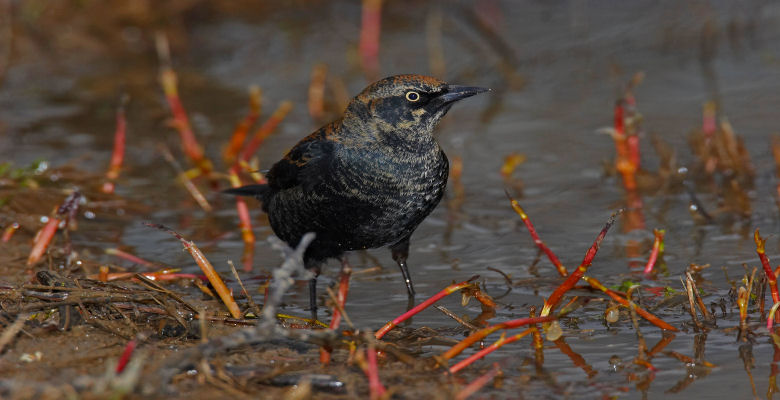Blackbirds singing in the dead of night

A team of scientists from the International Rusty Blackbird Working Group have undertaken a study which could be set to save one of the most steeply-declining songbirds in the U.S.
The findings published in PLOS ONE and led by Liverpool John Moores University reveal that the Rusty Blackbird, a species of conservation concern and listed as vulnerable, should be the target of conservation efforts to improve forested wetland habitat quality.
Forested wetlands belong to the most threatened habitats due to harvest and water management. In particular, bottomland hardwood forests in Mississippi, where the study was conducted, have decreased by 80% since European settlement but support a variety of species of conservation concern such as many Neotropical migrants, wintering ducks, other wintering songbirds and are important for recreational activities.
Rusty Blackbirds ( Euphagus carolinus ) are found year-round in forested wetlands breeding in boreal forests in Alaska and Canada and wintering in bottomland hardwood forests in the south-eastern U. S. They belong to the most steeply declining songbirds in the U.S. but little information is available to support priority birds such as the Rusty Blackbird on the wintering grounds. As a forested wetland specialist the species is an ideal indicator of effective habitat management.
Lead author, Dr Claudia Mettke-Hofmann, Reader in Animal Behaviour at the School of Natural Sciences and Psychology explains:
“We assessed age and sex distribution and body condition of Rusty Blackbirds among the three major habitats used by this species in the Lower Mississippi Alluvial Valley and also measured availability of acorns, pecan nuts and invertebrates, the Rusty blackbird’s main food.
"Conservation management decisions for many animals are often based on measures of species’ numbers during the breeding and non-breeding season. However, such measures become problematic when age and sex classes use different habitats during the non-breeding season as we found in the Rusty blackbird. Adult males occupied pecan groves which had the highest nut biomass, whereas females were found in forests which had the lowest nut biomass, with young males mainly using forest fragments along creeks with medium nut biomass.
"While this trend was opposite for invertebrates, they contributed only a small proportion to overall biomass. The segregation into different habitats seems to be driven by competition with the most competitive class, adult males, excluding other classes from high quality habitats.
Low winter habitat quality can be carried over into the next breeding season affecting unproportionately females. Improving food availability in bottomland hardwood forests through reforestation with acorn and pecan trees and changed water management could improve the situation and would also benefit other declining species such as waterfowl.”
The study was funded by grants from the U.S. Fish and Wildlife Service to the International Rusty Blackbird Working Group. CM-H received support by the Canadian Wildlife Service, Friends of the National Zoo, USA, the Max Planck Institute for Ornithology, Andechs, Germany, the German Ethological Society, the Society for Tropical Ornithology, Germany, and the Arthur-von-Gwinner Foundation, Austria.
The PLOS ONE article, Competition and habitat quality influence age and sex distribution in wintering Rusty Blackbirds
Image: copyright Gerhard@Hofmann-photography.de.


